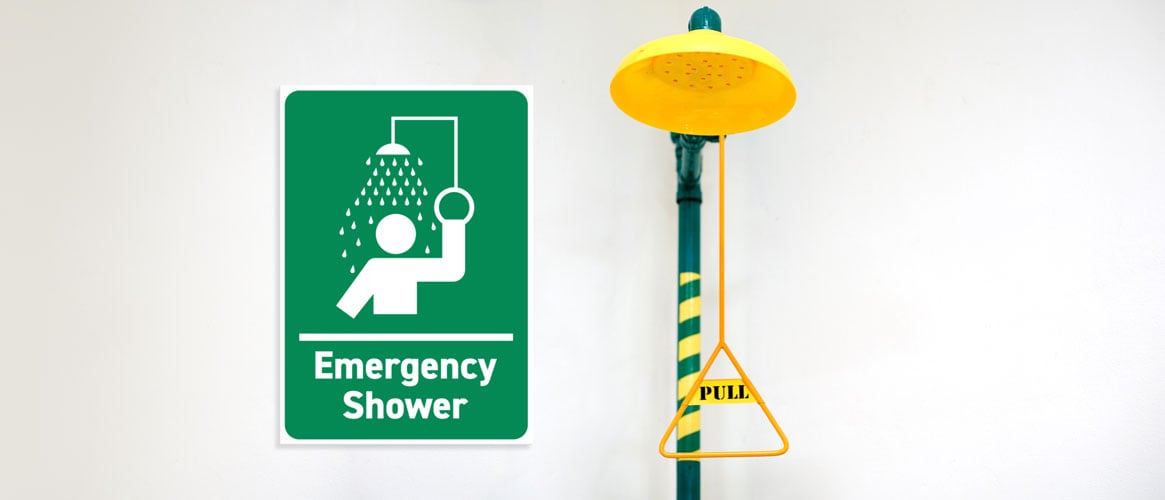When working with chemicals that are corrosive, severely irritating to the skin, or toxic by skin absorption, an emergency shower must be available to workers, and they need to be trained on how to use it. While emergency eyewash stations can flush chemicals out of the eyes, the shower is used to wash off the chemicals that come in contact with the skin.
Cal/OSHA requires plumbed shower units to be activated monthly to flush the line and verify function. Self-contained units must be maintained according to the manufacturer’s instructions. You can assign a worker to be responsible for this.
What your employees need to know about emergency showers
Emergency showers are designed to deliver at least 20 gallons of water per minute for at least 15 minutes. These showers are first aid only – additional medical care may be needed. Eye injuries may not be immediately obvious; if in doubt or when a clear injury is present, seek medical attention.
When is an emergency shower needed at the worksite? Employees should check the safety data sheet (SDS) for chemicals or ask their supervisor to find out if an emergency shower should be available.
Where is the shower located? The emergency shower should be within a 10-second walk from the work areaand the location of the shower should be marked with a highly visible sign.
How do I use the shower? Most emergency showers are equipped with a pull chain with a triangle-shaped handle, which when pulled activates the shower.
What your workers need to do when using emergency showers
Pull the handle and let the water wash over the body to decontaminate for at least 15 minutes.
Remove clothes if they are saturated with chemicals. If clothes are on fire, allow the water to extinguish the flames. Have scissors, towels, and a privacy curtain on hand should clothing need to be removed. Each employee should also have a change of clothes available. Don’t pull clothing off burnt or damaged skin. Remove jewelry, contacts, and shoes.
Be prepared for a large amount of water to run onto the floor (an emergency shower running for 15 minutes delivers 300 – 450 gallons of water). You can usually stop the shower by pushing the lever up.
Emergency shower units often have an attached eyewash station. You can use the eyewash station simultaneously in the event a worker’s eyes and skin were both contacted by hazardous substances.
Once the flushing process is complete, seek additional medical attention—when necessary— as soon as possible. Depending on the severity of the injury, this could be a trip to urgent care, an emergency room, or a call to 9-1-1.
And remember, make sure the pathway to the emergency shower is always clear. Keep equipment, boxes, cords, or any other material away from this path so your employees have unobstructed access.
What to cover at your safety meeting about emergency showers
Show your workers where the emergency shower is located and point out the highly visible sign that identifies where the emergency shower is. Also, remind everyone about keeping a clear pathway.
- Demonstrate how to operate the shower equipment.
- Remind workers to help others get to the shower and call 911 if necessary.
- Discuss how coworkers can assist with clothing and equipment removal and monitor the injured worker for medical symptoms. Remind everyone to keep extra clothes around or use an emergency first aid blanket to shield and warm the injured worker afterward.
- As part of your safety discussion, address the need to keep electrical equipment away from the shower area – which helps prevent electrical shock.
The best protection is prevention! The emergency shower is there to protect you when accidents and unexpected exposures occur.
(Rev. 11/2023)
